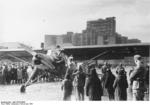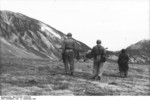Fi 156 Storch
| Country | Germany |
| Manufacturer | Gerhard Fieseler Werke |
| Primary Role | Other |
| Maiden Flight | 1 March 1936 |
Contributor: C. Peter Chen
ww2dbaseThe Fi 156 Storch ("Stork") aircraft were the result of a request from the German Luftwaffe in 1935 for liaison aircraft. They were designed to be versatile; they did not need a long runway to take off and land, and their foldable wings allowed ease of transportation inside trailers or even towed by vehicles. After the first prototype flight in the spring of 1936, the design was immediately ordered into production with a contract for 16 aircraft. The first Fi 156 Storch aircraft entered service in mid-1937. During WW2, they were found in all major theaters with German presence. In Sep 1943, after General Kurt Student's daring commando rescue of Benito Mussolini from the Campo Imperatore Hotel at Gran Sasso, Lieutenant Otto Skorzeny and Benito Mussolini were extricated via a Fi 156 Storch aircraft that landed on a short 50-meter clearing. In 26 Apr 1945, during the last days of the Berlin siege, the Fi 156 Storch aircraft piloted by Hanna Reitsch was the last to land on the improvised airstrip in the Tiergarten near the Brandenburg Gate, taking her lover Field Marshal Robert Ritter von Greim into Berlin for a meeting with Hitler. At least 60 Fi 156 Storch aircraft were captured by the Allies; one of them was assigned to Field Marshal Bernard Montgomery as his personal transport. Between 1937 and 1945, over 2,900 Fi 156 Storch aircraft were built, most of the C variant. Some of them were built at Mr·z factory in Czechoslovakia and Morane-Saulnier factory in France, both of which continued to build them after the war for civilian use, with design designation of K-65 C·p (also "Stork") and MS.500 Criquet ("Locust"), respectively.
ww2dbaseSource: Wikipedia.
Last Major Revision: Jul 2007
SPECIFICATIONS
Fi 156C
| Machinery | One Argus As 10 air-cooled inverted V8 engine rated at 240hp |
| Armament | 1x7.92mm rear MG 15 machine gun |
| Crew | 2 |
| Span | 14.30 m |
| Length | 9.90 m |
| Height | 3.10 m |
| Wing Area | 26.00 m² |
| Weight, Empty | 860 kg |
| Weight, Loaded | 1,260 kg |
| Speed, Maximum | 175 km/h |
| Rate of Climb | 4.80 m/s |
| Service Ceiling | 5,200 m |
| Range, Normal | 380 km |
Photographs
 |  |  |  |
Please consider supporting us on Patreon. Even $1 per month will go a long way! Thank you. Please help us spread the word: Stay updated with WW2DB: |
- » Wreck of M-49 Found (10 Apr 2025)
- » Japanese Emperor Visited Iwoto (Iwo Jima) (8 Apr 2025)
- » Race, Holocaust, and African-American WW2 Histories Removed from the US Naval Academy Library (7 Apr 2025)
- » US Government Plans to Purge WW2 Information (17 Mar 2025)
- » See all news
- » 1,167 biographies
- » 337 events
- » 44,601 timeline entries
- » 1,243 ships
- » 350 aircraft models
- » 207 vehicle models
- » 376 weapon models
- » 123 historical documents
- » 261 facilities
- » 470 book reviews
- » 28,497 photos
- » 365 maps
Joachim von Ribbentrop, German Foreign Minister, Aug 1939
Please consider supporting us on Patreon. Even $1 a month will go a long way. Thank you!
Or, please support us by purchasing some WW2DB merchandise at TeeSpring, Thank you!